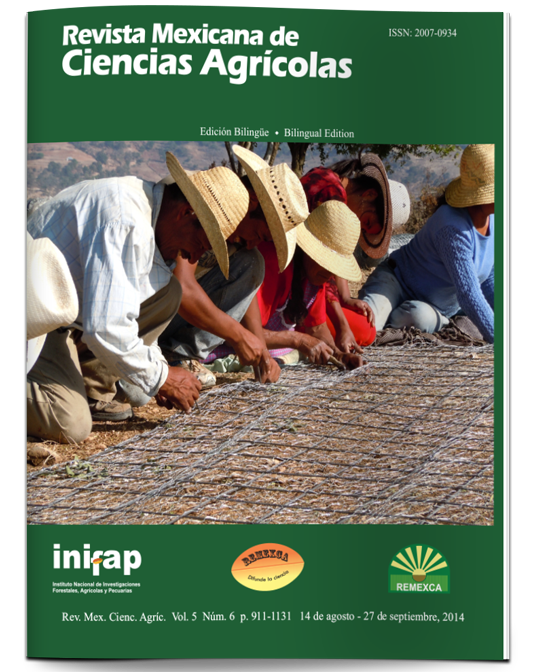Relationship between degree-days and the production of Opuntia ficus-indica for human consumption in Marin, Nuevo León
DOI:
https://doi.org/10.29312/remexca.v5i6.889Keywords:
hydroponics, mathematical model, cactus pearAbstract
Air temperature is the most related factor to plant growth and development. There are few investigations reported for growing cactus in northern Mexico that address modeling degree days with biomass production under hydroponic conditions. The objectives of this study were: i) production modeling of cactus pear related to fresh (PF) and dry (PS) biomass, with air temperature; and ii) estimate the rate of biomass growth in a closed hydroponic system. The experiment was conducted in (2009) in Marin, Nuevo Leon, Mexico. The variety “Villanueva” was used, with a population density of 16 plants m-2, a substrate of river sand and a complete nutrient solution. Irrigation was made every third day and the solution was renewed every week. The average values of temperature, relative humidity and degree day in the harvest period were: 29 oC, 55% RH and 558.2 degree days, respectively. Only two cladodes were left to maturity on the mother cladode and from them were harvested each week all shoots when they reached 15 cm or more in length. The ratio of PF, PS vs. degree days (GD) variables were adjusted to quadratic polynomials with R2= 0.83 and 0.91, respectively; the rate of increase was variable during the crop production cycle. The average monthly production of 16 plants was 4.36 and 0.72 kg m-2 of PF and PS, respectively.
Downloads
Downloads
Published
How to Cite
Issue
Section
License
The authors who publish in Revista Mexicana de Ciencias Agrícolas accept the following conditions:
In accordance with copyright laws, Revista Mexicana de Ciencias Agrícolas recognizes and respects the authors’ moral right and ownership of property rights which will be transferred to the journal for dissemination in open access. Invariably, all the authors have to sign a letter of transfer of property rights and of originality of the article to Instituto Nacional de Investigaciones Forestales, Agrícolas y Pecuarias (INIFAP) [National Institute of Forestry, Agricultural and Livestock Research]. The author(s) must pay a fee for the reception of articles before proceeding to editorial review.
All the texts published by Revista Mexicana de Ciencias Agrícolas —with no exception— are distributed under a Creative Commons License Attribution-NonCommercial 4.0 International (CC BY-NC 4.0), which allows third parties to use the publication as long as the work’s authorship and its first publication in this journal are mentioned.
The author(s) can enter into independent and additional contractual agreements for the nonexclusive distribution of the version of the article published in Revista Mexicana de Ciencias Agrícolas (for example include it into an institutional repository or publish it in a book) as long as it is clearly and explicitly indicated that the work was published for the first time in Revista Mexicana de Ciencias Agrícolas.
For all the above, the authors shall send the Letter-transfer of Property Rights for the first publication duly filled in and signed by the author(s). This form must be sent as a PDF file to: revista_atm@yahoo.com.mx; cienciasagricola@inifap.gob.mx; remexca2017@gmail.
This work is licensed under a Creative Commons Attribution-Noncommercial 4.0 International license.



